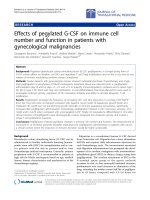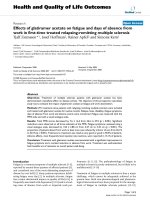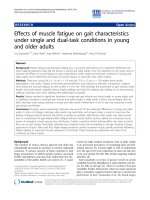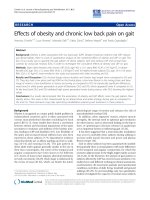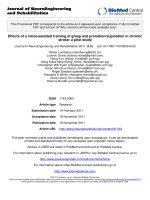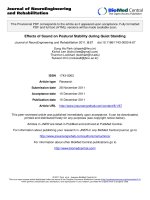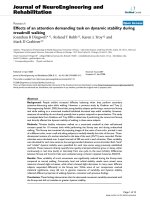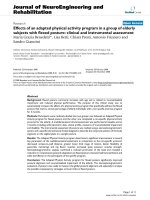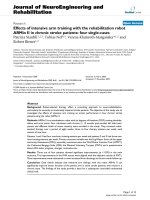báo cáo hóa học: "Effects of intensive arm training with the rehabilitation robot ARMin II in chronic stroke patients: four single-cases" potx
Bạn đang xem bản rút gọn của tài liệu. Xem và tải ngay bản đầy đủ của tài liệu tại đây (492.81 KB, 10 trang )
BioMed Central
Page 1 of 10
(page number not for citation purposes)
Journal of NeuroEngineering and
Rehabilitation
Open Access
Research
Effects of intensive arm training with the rehabilitation robot
ARMin II in chronic stroke patients: four single-cases
Patricia Staubli
1,2,3
, Tobias Nef
4,5
, Verena Klamroth-Marganska*
1,2
and
Robert Riener
1,2
Address:
1
Sensory-Motor Systems Lab, Institute of Robotics and Intelligent Systems, ETH Zurich, Switzerland,
2
Spinal Cord Injury Center, Balgrist
University Hospital, University Zurich, Switzerland,
3
Department of Biology, Institute of Human Movement Sciences and Sport, ETH Zurich,
Switzerland,
4
Department of Biomedical Engineering, The Catholic University of America, Washington D.C., USA and
5
Center for Applied
Biomechanics and Rehabilitation Research, National Rehabilitation Hospital, Washington D.C., USA
Email: Patricia Staubli - ; Tobias Nef - ; Verena Klamroth-
Marganska* - ; Robert Riener -
* Corresponding author
Abstract
Background: Robot-assisted therapy offers a promising approach to neurorehabilitation,
particularly for severely to moderately impaired stroke patients. The objective of this study was to
investigate the effects of intensive arm training on motor performance in four chronic stroke
patients using the robot ARMin II.
Methods: ARMin II is an exoskeleton robot with six degrees of freedom (DOF) moving shoulder,
elbow and wrist joints. Four volunteers with chronic (≥ 12 months post-stroke) left side hemi-
paresis and different levels of motor severity were enrolled in the study. They received robot-
assisted therapy over a period of eight weeks, three to four therapy sessions per week, each
session of one hour.
Patients 1 and 4 had four one-hour training sessions per week and patients 2 and 3 had three one-
hour training sessions per week. Primary outcome variable was the Fugl-Meyer Score of the upper
extremity Assessment (FMA), secondary outcomes were the Wolf Motor Function Test (WMFT),
the Catherine Bergego Scale (CBS), the Maximal Voluntary Torques (MVTs) and a questionnaire
about ADL-tasks, progress, changes, motivation etc.
Results: Three out of four patients showed significant improvements (p < 0.05) in the main
outcome. The improvements in the FMA scores were aligned with the objective results of MVTs.
Most improvements were maintained or even increased from discharge to the six-month follow-up.
Conclusion: Data clearly indicate that intensive arm therapy with the robot ARMin II can
significantly improve motor function of the paretic arm in some stroke patients, even those in a
chronic state. The findings of the study provide a basis for a subsequent controlled randomized
clinical trial.
Published: 17 December 2009
Journal of NeuroEngineering and Rehabilitation 2009, 6:46 doi:10.1186/1743-0003-6-46
Received: 31 March 2009
Accepted: 17 December 2009
This article is available from: />© 2009 Staubli et al; licensee BioMed Central Ltd.
This is an Open Access article distributed under the terms of the Creative Commons Attribution License ( />),
which permits unrestricted use, distribution, and reproduction in any medium, provided the original work is properly cited.
Journal of NeuroEngineering and Rehabilitation 2009, 6:46 />Page 2 of 10
(page number not for citation purposes)
Background
Stroke remains the leading cause of permanent disability.
Recent studies estimate that it affects more than 1 million
people in the EU [1,2] and more than 0.7 million in the
U.S. each year [3]. The major symptom of stroke is severe
sensory and motor hemiparesis of the contralesional side
of the body [4]. The degree of recovery highly depends on
the severity and the location of the lesion [5]. However,
only 18% of stroke survivors regain full motor function
after six months [6]. Restoration of arm and hand func-
tions is essential [6] to cope with tasks of daily living and
regain independence in life.
There is evidence that the rehabilitation plateau can be
prolonged beyond six months post-stroke and that
improvements in motor functions can be achieved even in
a chronic stage with appropriate therapy [7,8]. For this to
occur, effective therapy must comprise key factors con-
taining repetitive, functional, and task-specific exercises
performed with high intensity and duration [9-12].
Enhancing patients' motivation, cooperation, and satis-
faction can reinforce successful therapy [13]. Robot-
assisted training can provide such key elements for induc-
ing long-term brain plasticity and effective recovery [14-
19].
Robotic devices can objectively and quantitatively moni-
tor patients' progress - an additional benefit since clinical
assessments are often subjective and suffer from reliability
issues [20]. Patient-cooperative control algorithms
[21,22] can support patients' efforts only as much as
needed, thus allowing for intensive robotic intervention.
Several clinical studies have been successfully conducted
with endeffector based robots [14,16,17,23]. In these
robots, the human arm is connected to the robot at a sin-
gle (distal) limb only. Consequently, endeffector based
robots are easy to use but do not allow single joint torque
control over large ranges of motion. In general, they pro-
vide less guidance and support than exoskeleton robots
[24]. In this study we propose using an exoskeleton-type
robot for the intervention. Such a type of robot provides
superior guidance and permits individual joint torque
control [24]. The device used here is called ARMin and has
been developed over the last six years [21,25].
A first pilot study with three chronic stroke patients
showed significant improvements in motor functions
with intensive training using the first prototype ARMin I.
Since ARMin I provided therapy only to the shoulder and
elbow, there were no improvements in distal arm func-
tions [25]. Consequently, the goal was to develop a robot,
which enables a larger variability of different (also more
complex and functional) training modalities involving
proximal and distal joint axes [26,27].
For this study we used an enhanced prototype, ARMin II,
with six independently actuated degrees of freedom
(DOF) and one coupled DOF (Figure 1). The robot trains
both proximal joints (horizontal and vertical shoulder
rotation, arm inner - outer rotation, and elbow flexion -
extension) and distal joints (pro - supination of lower arm
and wrist flexion - extension). Together with an audiovis-
ual display, ARMin II provides a wide variety of training
modes with complex exercises and the possibility of per-
forming motivating games.
The goal of this study was to investigate the effects of
ARMin II training on motor function, strength and use in
everyday life.
Methods
Participants
Four patients (three male, one female) met the inclusion
criteria and volunteered in the study. The inclusion crite-
ria were i) diagnosis of a single ischemic stroke on the
right brain hemisphere with impairment of the left upper
extremity and ii) that stroke occurred at least twelve
months before study entrance.
Study exclusion criteria were 1) pain in the upper limb, so
that the study protocol could not be followed, 2) mental
illness or insufficient cognitive or language abilities to
understand and follow instructions, 3) cardiac pace-
maker, and 4) body weight greater than 120 kg.
Mechanical structure of the exoskeleton robot ARMin IIFigure 1
Mechanical structure of the exoskeleton robot
ARMin II. Axis 1: Vertical shoulder rotation, Axis 2: Hori-
zontal shoulder rotation, Axis 3: Internal/external shoulder
rotation, Axis 4: Elbow flexion/extension, Axis 5: Pro/supina-
tion of the lower arm, Axis 6: Wrist flexion/extension.
Journal of NeuroEngineering and Rehabilitation 2009, 6:46 />Page 3 of 10
(page number not for citation purposes)
All four patients received written and verbal information
about the study and gave written informed consent. The
protocol of the study was approved by the local ethics
committee.
Procedure
To investigate the effects of training with the rehabilita-
tion device ARMin II, four single-case studies with A-B
design were applied. Clinical evaluations of the Fugl-
Meyer Score of the upper extremity Assessment (FMA), the
Wolf Motor Function Test (WMFT), the Catherine Bergego
Scale (CBS), and the Maximal Voluntary Torques (MVTs)
were administered twice during a baseline period of three
weeks (A). A training phase of eight weeks (B) followed.
The same evaluation tools were applied every two weeks.
Patients 1 and 4 executed three training hours per week
(totally 24 hours over entire training period), patients 2
and 3 completed four training hours per week (totally 32
hours). A single training session comprised approximately
15 minutes passive mobilization and approximately 45
minutes active training. Training sessions were always led
by the same therapist.
Robotic therapy
ARMin II [21] allows for complex proximal and distal
motions in the functional 3-D workspace of the human
arm (Figure 1). The patient sits in a wheelchair (wheels
locked) and the arm is placed into an orthotic shell, which
is fixed and connected by three cuffs to the exoskeletal
structure of the robot. Position and force sensors support
active and passive control modes. Two types of therapy
modes were applied: a passive 'teach and repeat' mobiliz-
ing mode and a game mode with active training modali-
ties.
For the passive therapy, the therapist can carry out a
patient-specific mobilization sequence adapted to indi-
vidual needs and deficits, using the robot's 'teach and
repeat' mode. The therapist guides the mobilization
('teach') by moving the patient's arm in the orthotic shell.
The trajectory of this guided mobilization is recorded by
the robot, so that the same mobilization can be repeated
several times ('repeat'). The patient receives visual feed-
back from an avatar on the screen, that performs the same
movements in real-time. During the teaching sessions, the
robot is controlled by a zero-impedance mode, in which
the robot does not add any resistance to the movement, so
that the therapist consequently only feels the resistance of
the human arm. During the 'repeat' mode, the robot is
position-controlled and repeats the motion that has been
recorded before.
For the active part of the therapy, a ball game and a laby-
rinth scenario were selected (see Figure 2). In the ball
game, the patient moves a virtual handle on the screen.
The aim is to catch a ball that is rolling down a virtual
ramp by shifting the handle. When a patient is unable to
succeed, the robot provides support by directing the han-
dle to the ball (ARMin II in impedance-control mode). To
give the patient visual feedback, the color of the handle
turns from green to red when robot-support is delivered.
Acoustic feedback is provided when a ball is precisely
caught. The difficulty level of the ball game can be modi-
fied and adjusted to the patient's need by the therapist, i.e.
the number of joint axes involved, the starting arm posi-
tion, the range of motion, the robotic assistance, resist-
ance or opposing force, and speed.
In the labyrinth game, a red ball (cursor) moves according
to the patient's arm motions. The objective is to direct the
ball from the bottom to the top of the labyrinth. The cur-
sor must be moved accurately. If the ball touches the wall
too hard, it drops to the bottom and the game restarts.
Like the ball game, the labyrinth provides various training
modalities by changing the settings, such as the amount of
arm weight compensation, vertical support, number of
joint axes involved, working space and sensitivity of the
wall [28].
Outcome measurements
To ensure reproducibility and consistency of the testing
procedure, all measurements were executed by the same
person and with the same settings for each patient. Evalu-
ations were always completed before training sessions.
Subject in the robot ARMin II with labyrinth and ball game scenarioFigure 2
Subject in the robot ARMin II with labyrinth and ball
game scenario.
Journal of NeuroEngineering and Rehabilitation 2009, 6:46 />Page 4 of 10
(page number not for citation purposes)
Clinical assessments were filmed and later evaluated by an
independent "blinded" therapist from "Charité, Median
Clinic Berlin, Department Neurological Rehabilitation".
The main clinical outcome was the Fugl-Meyer Assess-
ment (FMA) of the upper-limb. This impairment-based
test consists of 33 items with a total maximum score of 66.
The test records the degree of motor deficits and reflexes,
the ability to perform isolated movements at each joint
and the influence of abnormal synergies on motion [29].
It shows good quality factors (reliability and validity)
[30,31] and it is widely used for clinical and research
assessments [32].
The Wolf Motor Function Test (WMFT) is a 15-item
instrument to quantify disability and to assess perform-
ance of simple and complex movements as well as func-
tional tasks [33]. This test has high interrater reliability,
internal consistency, and test-retest reliability [34]. The
WMFT is responsive to patients with mild to moderate
stroke impairments. However, for severely affected
patients it has low sensitivity due to a floor effect (when
single test items are too difficult).
Severity of neglect was evaluated with the Catherine
Bergego Scale (CBS), a test that shows good reliability,
validity [35], and sensitivity [36].
To assess sensory functions of the upper limb, the Ameri-
can Spinal Injury Association (ASIA) scoring system was
used [37]. The degree of sensation to pinprick (absent = 0,
impaired = 1, normal = 2) was determined at the key sen-
sory points of the C4 to T1 dermatomes. The single scores
were summed.
In addition, a questionnaire was designed, referring to
ADL-tasks, progress, changes, motivation etc. The patients
then had to rate the different questions on a scale from 1
to 10, and furthermore, add a comment, expressing their
subjective experiences and impressions.
Measurements with ARMin II
With the ARMin II robot, maximal voluntary torques
(MVTs) were determined for six isometric joint actions
including vertical shoulder flexion and extension, hori-
zontal shoulder abduction and adduction, as well as
elbow flexion and extension. Patients were seated in a
locked wheelchair with the upper body fixed by three belts
(two crosswise diagonal torso belts and one belt over the
waist) to prevent the torso from assisting the movements.
The starting position was always the same. The shoulder
was flexed 70° and transversally abducted 20°, the rota-
tion of the upper and lower arm was neutral (0°), and the
elbow was flexed 90°. Patients were instructed to generate
maximal isometric muscle contractions against the resist-
ance of ARMin II for at least two seconds before relaxing.
During the effort, verbal encouragement was given in each
case.
Data analysis
From the main baseline measurements - FMA, WMFT,
CBS, and MVT - the mean values and standard deviations
were calculated. Data recorded during the intervention
phases were evaluated by using the least square linear
regression model with applied bootstrap resampling tech-
nique [38]. For the statistical analysis, the programs SYS-
TAT 12 and Matlab 6.1 were used. The significance level p
≤ 0.05 of the slope of the regression line was considered
to indicate a statistically significant improvement.
Results
The results of the FMA are presented in Table 1. From
baseline to discharge, patients 1, 2, and 3 increased their
scores significantly (p < 0.05). They continued to improve
in the FMA at the six-month follow-up (see Figure 3).
Patient 1 gained +17.6 points in the FMA (from 21 to 38.6
points), while at the follow-up, six months later, he dem-
onstrated even further impressive progress, without hav-
ing received additional therapy in the mean time. Overall,
patient 1 showed an absolute improvement of +29 points
(from 21 to 50 points), particularly due to high recovery
in distal arm functions (+21 points).
The FMA gains of patients 2 and 3 were +5 points (from
24 to 29 points) and +8 points (from 11 to 19 points).
These findings were in line with other investigations
about the effects of robot-assisted therapy in chronic
stroke patients that demonstrated changes between 3.2
and 6.8 points [14,23,39-43]. However, one must note
that such comparisons have to be done with care since
studies often differ in methods and criteria (e.g. interven-
tion time, number of training sessions per week, duration
of training sessions, type of stroke, affected brain side,
time post-stroke, and severity of lesion). Patient 4 showed
an increase of +3 points (from 10 to 13 points) in the
FMA; however, this increase was statistically not signifi-
cant.
Typical arm functions that are relevant for activities of
daily life can be expressed by the WMFT (Table 2). During
the therapy, the WMFT scores of patients 1, 2 and 3
increased by +1.00, +0.5, and +0.86 points, respectively.
Patients 2 and 3 slightly diminished at follow-up. Never-
theless, these three patients achieved significant progress
(p < 0.05), in contrast to patient 4, who showed no signif-
icant improvement. However, at the follow-up examina-
tion, patient 4 was the only one who further improved in
the WMFT (see Figure 4).
Journal of NeuroEngineering and Rehabilitation 2009, 6:46 />Page 5 of 10
(page number not for citation purposes)
A questionnaire was used to obtain further information
about patient status. The patients reported progress of the
affected upper extremity in everyday life activities (e.g. the
arm can be lifted higher and better, is more integrated,
feels lighter and is less stiff, able to lift glass, fold laundry,
use index finger, and control motions better). The grades
of patients 1 to 4 regarding the use of their impaired arm
during ADLs after the intervention (scale range 1 to 10, no
better use = 1, much better use = 10) were 5, 7, 4 and 3,
respectively. Furthermore, they described to be more
motivated and willing to try to engage their arm in diverse
daily activities.
An overview of the MVTs, consisting of six different torque
measurements, is presented in Table 3. At the follow-up,
improvement in muscle strength increased in patient 1,
while it slightly diminished in patients 2 and 3. In patient
4, muscle strength returned to the base level at the follow-
up.
The demographic data and clinical characteristics of the
four patients are summarized in Table 4. None of the
patients reported any adverse effects from robot-mediated
therapy. In contrast, patients 3 and 4 described reduced
hardening and pain of their neck and shoulder muscles.
Patients 1, 2 and 3 completed measurements and therapy
sessions, except for patient 4, who missed one measure-
ment date and two therapy sessions for reasons that are
not related to the study.
Discussion
In this study, intensive therapy using the robot ARMin II
was administered to four chronic stroke patients during
eight weeks of training. Patients 1 and 4 received 32 and
Table 1: Overview of the Fugl-Meyer Assessment
FMA: Total
§
sh/e
§
w/h
§
Baseline Post-
therapy
Difference
†
Follow
up (6 mt)
Difference
‡
Total
change
R
2
p
S1: Total 21 38.6 +17.6 50 +11.4 +29 0.943 0.001*
sh/e 20 24.0 +4.0 28 +4.0 +8
w/h 1 14.6 +13.6 22 +7.4 +21
S2: Total 24 27.1 +3.1 29 +1.9 +5 0.800 0.041*
sh/e 21 23.1 +2.1 24 +0.9 +3
w/h 3 4.0 +1.0 5 +1.0 +2
S3: Total 11 17.8 +6.8 19 +1.2 +8 0.908 0.003*
sh/e 10 15.8 +
5.8
18 +2.2 +8
w/h 1 2.0 +1.0 1 -1.0 +0
S4: Total 10 12.1 +2.1 13 +0.9 +3 0.408 0.172
sh/e 10 12.1 +2.1 12 -0.1 +2
w/h 0 0 +0 1 +1.0 +1
Note: An increase in score indicates improvement. S1 - S4 means subject 1 to 4.
§Fugl-Meyer (FMA), total score, maximum = 66; score for shoulder/elbow (sh/e), max. = 36; score for wrist/hand (w/h), max. = 30
†Difference of score between baseline and post-test.
‡Difference of score between post-test and follow up.
*Indicate significant p-values < 0.05
Clinical FMA scores across evaluation sessionsFigure 3
Clinical FMA scores across evaluation sessions.
Journal of NeuroEngineering and Rehabilitation 2009, 6:46 />Page 6 of 10
(page number not for citation purposes)
30 hours of therapy respectively, while patients 2 and 3
received 24 hours.
The results of these single-case series underline prior find-
ings with robotic therapy, namely that intensive, repeti-
tive, task-specific, and goal-directed training can
significantly improve motor functions in chronic stroke
patients - even years post-stroke [14,23,44]. All four
patients demonstrated improvements in motor and func-
tional activities, but to various degrees. Overall, they sus-
tained their functional gains at the six-month follow-up
or even continued to improve after the end of treatment,
indicating potential long-term benefits of robot-assisted
therapy.
Patient 4 had the lowest motor functions at study entrance
and hardly any sensation in the clinical pinprick test. Such
neurological deficits can make functional therapy very dif-
ficult as feedback functions are not, or hardly, available.
This might explain why patient 4 could only profit little
from the training with ARMin II. For stroke individuals
with little sensory functions, as e.g. patient 4, a sensory
intervention is suggested to be a more effective approach
[45]. In general, it can be said that stroke patients with
severe sensory loss benefited less from treatment than
moderately impaired patients [10,46].
The gains in the WMFT likely reflect increased motor per-
formance levels that are suggested to facilitate use of the
impaired upper limb in daily activities. These changes
seemed to be clinically significant from the patients' per-
spective. However, the analysis suggested that the
impaired upper limb was mainly involved as an assist in
bimanual ADLs after intervention. In addition, one must
note that not only gains in motor abilities were achieved,
but also positive impacts on concentration, neglect, phys-
ical capacity, well-being, body balance and posture were
noticed. Patient 4, for example, diminished twelve points
in the CBS, indicating a reduced neglect (Table 5).
The different responses of this pilot research could be
explained by patients' heterogeneity, as patients differed
in terms of age, time post-stroke, affected brain areas, sen-
sation, muscle tone, etc. (Table 4) - all factors that influ-
ence motor relearning. The highest motor recoveries were
experienced by patient 1, the youngest and least chronic
patient. But note that patient 1 like patient 4 received
more intensive intervention than the other two patients. It
seems that treatment, with additional therapy hours, is
primarily fruitful and beneficial for patients with a certain
level of remaining sensory functions and motor abilities.
In a comparable study that has been conducted with the
robot ARMin I, patients I and II received 24 hours of ther-
apy, while patient III received 40 hours. The improvement
of patients I, II and III were +3.1, +3.0, and +4.2 points
(initial FMA scores were 14, 26 and 15).
The reason for the less distinctive improvements with the
former version ARMin I and other previous robots might
be due to the limited movement capabilities (only proxi-
mal [14,47,48] or distal [49] arm involvement) or the
Table 2: Overview of the Wolf Motor Function Test
WMFT
§
Baseline Post-
therapy
Difference
†
Follow up
(6 mt)
Difference
‡
Total
change
R
2
p
S1: 1.86 2.86 +1.00 2.86 0 +1.00 0.911 0.003*
S2: 2.07 2.57 +0.50 2.50 -0.07 +0.43 0.891 0.005*
S3: 1.07 1.93 +0.86 1.79 -0.14 +0.72 0.831 0.011*
S4: 0.93 1.07 +0.14 1.29 +0.22 +0.36 0.577 0.080
Note: An increase in score indicates functional improvement. S1 - S4 means subject 1 to 4.
§Wolf Motor Function Test (WMFT), 5 = normal motor functions.
*Indicate significant p-values < 0.05
Clinical WMFT scores across evaluation sessionsFigure 4
Clinical WMFT scores across evaluation sessions.
Journal of NeuroEngineering and Rehabilitation 2009, 6:46 />Page 7 of 10
(page number not for citation purposes)
missing control of proximal joints (endeffector-based
robots). In contrast, ARMin II allows for authentic motion
sequences, including coordinated interactions between
wrist, elbow and shoulder joints. This seems to be an
important feature since most everyday activities are com-
posed of inter-joint coordination. ARMin II is an exoskel-
eton-based robot and, in general, better suited to train
ADL-tasks than an endeffector-based robot. This is
because, in an exoskeleton robot, the human arm is very
well supported and guided by the robot, movements with
large ROM can be trained, and the interaction torques that
the robot apply to each joint of the human arm can be
controlled individually.
Complex movements also enable patients to break abnor-
mal synergy patterns that are limiting arm motor func-
tions [50-52]. As ARMin II provides support against
gravity, abnormal synergy patterns in hemiparetic limbs
can progressively be learned to be overcome, a matter that
was observed in patients 1, 2 and 3. For this therapy issue,
the labyrinth scenario seemed to be particularly suitable,
as the parameters can be highly varied and adapted indi-
vidually to the patient's needs. Similar to these findings,
Sukal et al. [53] have shown in their research that a
reduced range of motion in stroke patients was a result of
pathologic synergies during arm lifting. By de-weighting
and supporting the impaired arm in training sessions, the
effect of gravity could be overcome.
Another approach by Ellis et al. [52] demonstrated that
abnormal joint torque coupling could be modified by
'multi-DOF progressive resistance training' in severely
Table 3: Overview of Total Maximal Voluntary Torques (MVTs)
MVT
§
(Nm) Baseline Post-
therapy
Difference
†
Follow up
(6 mt)
Difference
‡
Total
change
S1: 17.6 ± 7.5 31.6 ± 9.0 +14.0 36.4 ± 10.9 +4.8 +18.8
S2: 6.1 ± 5.2 14.4 ± 3.4 +8.3 12.9 ± 5.2 -1.5 +6.8
S3: 9.6 ± 6.7 22.4 ± 10.7 +12.7 19.2 ± 13.3 -3.2 +9.6
S4: 2.6 ± 2.0 8.3 ± 3.4 +5.7 3.4 ± 2.9 -4.9 +0.8
Note: An increase in Nm indicates improvement in muscle torque. S1 - S4 means subject 1 to 4.
§Total of maximal voluntary torques (Nm): Consists of 6 different torque measurements (shoulder flexion - extension; horizontal shoulder
rotation; elbow flexion - extension).
†Difference of Nm between baseline and post-test.
‡Difference of Nm between post-test and follow up.
Table 4: Data on the Subjects at Admission
S1 S2 S3 S4
Gender Male female male male
Age 39 60 54 58
Handedness (before stroke) Right right right right
Hemisphere of unilateral stroke Right right right right
Diagnosis of stroke ischemic media insult right,
bleeding into Ncl. Lentiformis
ischemic media insult right,
in the temporal dorsal brain
ischemic insult
in the right PCA*
ischemic media
insult right
Months post-stroke (at entrance) 12 131 22 16
Reflex Status (0/+/++/+++) ++ +++ +++ +++
Sensation, pin prick, C4-T1 (0-24) 20 22 24 7
F. Independence Measure (18-126) 103 121 112 90
Fugl-Meyer Assessment UL (0-66) 21 24 11 9
Wolf Motor Function Test (0-5) 1.80 2.07 1.01 0.35
Catherine Bergego Scale (0-30) 5 4 12 16
Modified Asworth Scale (0-5)
Elbow 0 3 3 3
Wrist 0 3 3 3
Finger 2 3 3 3
Note: Tests refer to the impaired body side. Functional Independence Measure: 18 = being completely dependent, 126 = acting completely
independent. Wolf Motor Function Test: 0 = no motor functions, 75 = normal motor functions. Fugl-Meyer Assessment: 0 = no motor functions,
66 = normal motor functions. Catherine Bergego Scale: Neglect: 0 = normal, 30 = severe neglect. Modified Asworth: 0 =no spasticity, 5 = severe
spasticity. Reflex Status: 0 = no reflex, '+' = moderate reflex,
'++' = normal reflex, '+++' = vigorous reflex. Sensation, pin prick C4 to T1: absent = 0, impaired = 1, normal = 2, max 24.
Journal of NeuroEngineering and Rehabilitation 2009, 6:46 />Page 8 of 10
(page number not for citation purposes)
impaired chronic stroke individuals. Patients gained
strength and simultaneously improved in multi-DOF
joint torque combinations. The same relationship could
also be observed in the patients that participated in this
pilot study. An increase in muscle strength was associated
with a larger active range of motion as well as improved
muscle coordination. Patients dissociated from synergistic
co-activation in the FMA and WMFT.
A distinct finding of the ARMin II study was that post-
treatment further progress was achieved in the FMA. These
continuing improvements might be due to therapy of dis-
tal arm functions since neither the ARMin I study showed
such additional effects at follow-up nor any other proxi-
mal robotic study in literature that the authors are aware
of. Krebs et al. [41] found that training of the more distal
limb segments led to twice as much carryover effect to the
proximal segments than vice-versa. Moreover, they
observed that improvement in more distal segments con-
tinued significantly even without further training for that
particular limb segment. This finding supports our
assumption that the patients were better able to use their
arm in daily activities after robotic treatment, allowing
them to further improve at the six-month follow up.
With eight weeks of robot training, patient 1 enhanced his
performance to such an extent (from initially 21 points to
50 points in the follow-up in the FMA) that he reached a
higher functional state - opening up new therapy
approaches like constrained induced movement therapy
CIMT.
In the present study the two game scenarios (labyrinth
and ball game), were particularly suitable to create an
enjoyable, efficient and motivating intervention. Patients'
interests could be incorporated into therapy by choosing
different game settings and levels with miscellaneous arm
positions and various joint axes. Nevertheless, comple-
mentary therapy modes focusing on specific ADL-tasks
and/or virtual reality scenarios might additionally help to
facilitate a transfer to ADLs [26,27]. An additional hand
module for opening and closing hand function and/or
single finger functions would enable more specific and
individualized therapy of hand and fingers, allowing for
the implementation of more authentic ADL-tasks.
So far, treatment with robotic devices [17,19,54] shows
no consistent improvement in functional abilities of daily
activities. Although high functional improvements and a
transfer to ADLs were achieved in this investigation, these
findings are limited to single cases. The pilot study
included only four, rather heterogeneous chronic stroke
patients. Despite the fact that functional stability could be
verified in all patients at baseline, no separate control
group was used. All patients continued with their conven-
tional outpatient therapies (maximum 1 hour of physical
and occupational therapy per week, focusing on the gait
and posture only). However, the patients were encour-
aged to continue their standard therapies on a constant
level, so that possible improvements due to this small
amount of conventional therapy can be excluded from the
study. Overall, these encouraging results definitely justify
starting a large randomized clinical trial.
Conclusion
This paper presents preliminary results of a pilot study
with four heterogeneous, chronic stroke patients using the
robotic device ARMin II. The findings support the
assumption that robot therapy can significantly influence
therapy outcomes. A robot that includes proximal and
distal joints, such as ARMin II, allows for a wide field of
specific training modalities with natural and complex
motions.
In this study it was noted that a subgroup of patients
could achieve a transfer to ADLs after performing the
training phase. This finding is of great importance since
treatment with robotic devices to date did not result in
consistent improvement in activities of daily living. A
transfer to everyday life should be indeed a central inten-
tion of rehabilitation as it brings independence and
improve quality of life.
Competing interests
Tobias Nef and Robert Riener are inventors of patents
describing the ARMin invention (WO2006058442,
EP1827349, EP07020795). The owners of the patents are
the ETH Zurich and the University of Zurich.
Authors' contributions
PS developed the study design, performed subject recruit-
ment, data acquisition and statistical analysis. She was the
primary composer of this manuscript. TN provided feed-
back and expert guidance throughout this study and was
also involved in data analysis. TN and RR designed and
built the robotic device ARMin II used in this work. All
four authors contributed significantly to the intellectual
Table 5: Overview of Catherine Bergego Scale
Catherine Bergego Scale: Neglect
Baseline Post-therapy 6-mo Follow up Change
S1: 5 3 4 -1
S2: 4 3 2 -2
S3: 12 2 3 -9
S4: 16 11 4 -12
Note: Lower score of CBS means a reduction of neglect (0 = normal,
30 = severe neglect).
Journal of NeuroEngineering and Rehabilitation 2009, 6:46 />Page 9 of 10
(page number not for citation purposes)
content of the manuscript and have approved the final
version to be published.
Acknowledgements
This project was supported by the National Centre of Competence in
Research, Neural Plasticity and Repair (subprojects 7 and 8). A special
thank you goes to Oliver Maric, MD, for his accomplishment of the physical
examinations of all patients. Furthermore, we want to express our grati-
tude to Stefanie van Kaick, MSc OT, and Cordula Werner, MSc OT, for
their blinded ratings of the clinical assessments. Special thanks also go to
Volker Dietz, MD and Claudia Rudhe-Link, MSc OT for their assistance as
scientific advisors. Finally, we would like to thank all patients who kindly
participated in this time consuming study.
References
1. Thorvaldsen P, Asplund K, Kuulasmaa K, Rajakangas AM, Schroll M:
Stroke incidence, case fatality, and mortality in the WHO
MONICA project. World Health Organization Monitoring
Trends and Determinants in Cardiovascular Disease. Stroke
1995, 26:361-367.
2. Brainin M, Bornstein N, Boysen G, Demarin V: Acute neurological
stroke care in Europe: results of the European Stroke Care
Inventory. Eur J Neurol 2000, 7:5-10.
3. Rosamond W, Flegal K, Friday G, Furie K, Go A, Greenlund K, Haase
N, Ho M, Howard V, Kissela B, et al.: Heart disease and stroke
statistics 2007 update: a report from the American Heart
Association Statistics Committee and Stroke Statistics Sub-
committee. Circulation 2007, 115:e69-171.
4. Maeurer HC, Diener HC: Der Schlaganfall Stuttgart: Georg Thieme
Verlag; 1996.
5. Rossini PM, Calautti C, Pauri F, Baron JC: Post-stroke plastic reor-
ganisation in the adult brain. Lancet Neurol 2003, 2:493-502.
6. Nakayama H, Jorgensen HS, Raaschou HO, Olsen TS: Recovery of
upper extremity function in stroke patients: the Copenha-
gen Stroke Study. Arch Phys Med Rehabil 1994, 75:394-398.
7. Carey JR, Kimberley TJ, Lewis SM, Auerbach EJ, Dorsey L, Rundquist
P, Ugurbil K: Analysis of fMRI and finger tracking training in
subjects with chronic stroke. Brain 2002, 125:773-788.
8. Lee J van der, Wagenaar R, Lankhorst G, Vogelaar T, Deville W,
Bouter L: Forced Use of the Upper Extremity in Chronic
Stroke Patients: Results From a Single-Blind Randomized
Clinical Trial. Stroke 1999, 30:2369-2375.
9. Kwakkel G, Wagenaar RC, Koelman TW, Lankhorst GJ, Koetsier JC:
Effects of intensity of rehabilitation after stroke. A research
synthesis. Stroke 1997, 28:1550-1556.
10. Sunderland A, Tinson DJ, Bradley EL, Fletcher D, Langton Hewer R,
Wade DT: Enhanced physical therapy improves recovery of
arm function after stroke. A randomised controlled trial. J
Neurol Neurosurg Psychiatry 1992, 55:530-535.
11. Butefisch C, Hummelsheim H, Denzler P, Mauritz KH: Repetitive
training of isolated movements improves the outcome of
motor rehabilitation of the centrally paretic hand. J Neurol Sci
1995, 130:59-68.
12. Kwakkel G, van Peppen R, Wagenaar RC, Wood Dauphinee S, Rich-
ards C, Ashburn A, Miller K, Lincoln N, Partridge C, Wellwood I,
Langhorne P: Effects of augmented exercise therapy time after
stroke: a meta-analysis. Stroke 2004, 35:2529-2539.
13. Maclean N, Pound P, Wolfe C, Rudd A: Qualitative analysis of
stroke patients' motivation for rehabilitation. BMJ 2000,
321:1051-1054.
14. Lum PS, Burgar CG, Shor PC, Majmundar M, Loos M Van der: Robot-
assisted movement training compared with conventional
therapy techniques for the rehabilitation of upper-limb
motor function after stroke. Arch Phys Med Rehabil 2002,
83:952-959.
15. Reinkensmeyer DJ, Emken JL, Cramer SC: Robotics, motor learn-
ing, and neurologic recovery. Annu Rev Biomed Eng 2004,
6:497-525.
16. Riener R, Nef T, Colombo G: Robot-aided neurorehabilitation
of the upper extremities. Med Biol Eng Comput 2005, 43:2-10.
17. Prange GB, Jannink MJ, Groothuis-Oudshoorn CG, Hermens HJ,
Ijzerman MJ: Systematic review of the effect of robot-aided
therapy on recovery of the hemiparetic arm after stroke. J
Rehabil Res Dev 2006, 43:171-184.
18. Nelles G: Cortical reorganization effects of intensive ther-
apy. Restor Neurol Neurosci 2004, 22:239-244.
19. Kwakkel G, Kollen BJ, Krebs HI: Effects of robot-assisted therapy
on upper limb recovery after stroke: a systematic review.
Neurorehabil Neural Repair 2008, 22:111-121.
20. Wade DT: Evaluating outcome in stroke rehabilitation (qual-
ity control and clinical audit). Scand J Rehabil Med Suppl 1992,
26:97-104.
21. Nef T, Mihelj M, Riener R: ARMin: a robot for patient-coopera-
tive arm therapy. Med Biol Eng Comput 2007, 45:887-900.
22. Mihelj M, Nef T, Riener R: A novel paradigm for patient-cooper-
ative control of upper limb rehabilitation robots. Advanced
Robotics 2007,
21:843-867.
23. Fasoli SE, Krebs HI, Stein J, Frontera WR, Hughes R, Hogan N:
Robotic therapy for chronic motor impairments after
stroke: Follow-up results. Arch Phys Med Rehabil 2004,
85:1106-1111.
24. Nef T, Guidali M, Riener R: ARMin III - Arm therapy exoskele-
ton with an ergonomic shoulder actuation. Applied Bionics and
Biomechanics 2009, 6:127-142.
25. Nef T, Quinter G, Muller R, Riener R: Effects of Arm Training
with the Robotic Device ARMin I in Chronic Stroke: Three
Single Cases. Neurodegener Dis 2009 in press.
26. Bayona NA, Bitensky J, Salter K, Teasell R: The role of task-specific
training in rehabilitation therapies. Top Stroke Rehabil 2005,
12:58-65.
27. Carey JR, Bhatt E, Nagpal A: Neuroplasticity promoted by task
complexity. Exerc Sport Sci Rev 2005, 33:24-31.
28. Carr JH, Shepherd RB: A motor learning model for rehabilita-
tion. In Movement science: foundations for physical therapy in rehabilita-
tion Rockville (MD): Aspen; 1987:31-91.
29. Fugl-Meyer AR, Jaasko L, Leyman I, Olsson S, Steglind S: The post-
stroke hemiplegic patient. 1. a method for evaluation of
physical performance. Scand J Rehabil Med 1975, 7:13-31.
30. Duncan PW, Propst M, Nelson SG: Reliability of the Fugl-Meyer
assessment of sensorimotor recovery following cerebrovas-
cular accident. Phys Ther 1983, 63:1606-1610.
31. Gladstone DJ, Danells CJ, Black SE: The fugl-meyer assessment of
motor recovery after stroke: a critical review of its measure-
ment properties. Neurorehabil Neural Repair 2002, 16:232-240.
32. Amirabdollahian F, Loureiro R, Gradwell E, Collin C, Harwin W, John-
son G: Multivariate analysis of the Fugl-Meyer outcome
measures assessing the effectiveness of GENTLE/S robot-
mediated stroke therapy. J Neuroengineering Rehabil 2007, 4:4.
33. Wolf SL, Catlin PA, Ellis M, Archer AL, Morgan B, Piacentino A:
Assessing Wolf motor function test as outcome measure for
research in patients after stroke. Stroke
2001, 32:1635-1639.
34. Morris DM, Uswatte G, Crago JE, Cook EW, Taub E: The reliability
of the wolf motor function test for assessing upper extremity
function after stroke. Arch Phys Med Rehabil 2001, 82:750-755.
35. Azouvi P, Olivier S, de Montety G, Samuel C, Louis-Dreyfus A, Tesio
L: Behavioral assessment of unilateral neglect: study of the
psychometric properties of the Catherine Bergego Scale.
Arch Phys Med Rehabil 2003, 84:51-57.
36. Halligan PW, Marshall JC, Wade DT: Visuospatial neglect: under-
lying factors and test sensitivity. Lancet 1989, 2:908-911.
37. Ditunno JF Jr, Young W, Donovan WH, Creasey G: The interna-
tional standards booklet for neurological and functional clas-
sification of spinal cord injury. American Spinal Injury
Association. Paraplegia 1994, 32:70-80.
38. Parker RI: Increased reliability for single-case research results:
is the bootstrap the answer? Behav Ther 2006, 37:326-338.
39. Volpe BT, Lynch D, Rykman-Berland A, Ferraro M, Galgano M, Hogan
N, Krebs HI: Intensive Sensorimotor Arm Training Mediated
by Therapist or Robot Improves Hemiparesis in Patients
With Chronic Stroke. Neurorehabil Neural Repair 2008,
22:305-310.
40. Krebs HI, Mernoff S, Fasoli SE, Hughes R, Stein J, Hogan N: A com-
parison of functional and impairment-based robotic training
in severe to moderate chronic stroke: a pilot study. NeuroRe-
habilitation 2008, 23:81-87.
41. Krebs HI, Volpe BT, Williams D, Celestino J, Charles SK, Lynch D,
Hogan N: Robot-aided neurorehabilitation: a robot for wrist
rehabilitation. IEEE Trans Neural Syst Rehabil Eng 2007, 15:327-335.
Publish with BioMed Central and every
scientist can read your work free of charge
"BioMed Central will be the most significant development for
disseminating the results of biomedical research in our lifetime."
Sir Paul Nurse, Cancer Research UK
Your research papers will be:
available free of charge to the entire biomedical community
peer reviewed and published immediately upon acceptance
cited in PubMed and archived on PubMed Central
yours — you keep the copyright
Submit your manuscript here:
/>BioMedcentral
Journal of NeuroEngineering and Rehabilitation 2009, 6:46 />Page 10 of 10
(page number not for citation purposes)
42. Coote S, Murphy B, Harwin W, Stokes E: The effect of the GEN-
TLE/s robot-mediated therapy system on arm function after
stroke. Clin Rehabil 2008, 22:395-405.
43. McCombe Waller S, Whitall J: Hand dominance and side of
stroke affect rehabilitation in chronic stroke. Clin Rehabil 2005,
19:544-551.
44. Liepert J, Bauder H, Wolfgang HR, Miltner WH, Taub E, Weiller C:
Treatment-induced cortical reorganization after stroke in
humans. Stroke 2000, 31:1210-1216.
45. Sullivan JE, Hedman LD: Sensory dysfunction following stroke:
incidence, significance, examination, and intervention. Top
Stroke Rehabil 2008, 15:200-217.
46. Cirstea MC, Ptito A, Levin MF: Arm reaching improvements
with short-term practice depend on the severity of the
motor deficit in stroke. Exp Brain Res 2003, 152:476-488.
47. Krebs HI, Volpe BT, Aisen ML, Hogan N: Increasing productivity
and quality of care: robot-aided neuro-rehabilitation. J Rehabil
Res Dev 2000, 37:639-652.
48. Reinkensmeyer DJ, Kahn LE, Averbuch M, McKenna-Cole A, Schmit
BD, Rymer WZ: Understanding and treating arm movement
impairment after chronic brain injury: progress with the
ARM guide. J Rehabil Res Dev 2000, 37:653-662.
49. Hesse S, Schulte-Tigges G, Konrad M, Bardeleben A, Werner C:
Robot-assisted arm trainer for the passive and active prac-
tice of bilateral forearm and wrist movements in hemi-
paretic subjects. Arch Phys Med Rehabil 2003, 84:915-920.
50. Beer RF, Dewald JP, Rymer WZ: Deficits in the coordination of
multijoint arm movements in patients with hemiparesis: evi-
dence for disturbed control of limb dynamics. Exp Brain Res
2000, 131:305-319.
51. Dewald JP, Beer RF: Abnormal joint torque patterns in the
paretic upper limb of subjects with hemiparesis. Muscle Nerve
2001, 24:273-283.
52. Ellis MD, Holubar BG, Acosta AM, Beer RF, Dewald JP:
Modifiability
of abnormal isometric elbow and shoulder joint torque cou-
pling after stroke. Muscle Nerve 2005, 32:170-178.
53. Sukal TM, Ellis MD, Dewald JP: Source of work area reduction
following hemiparetic stroke and preliminary intervention
using the ACT3D system. Conf Proc IEEE Eng Med Biol Soc 2006,
1:177-180.
54. Mehrholz J, Platz T, Kugler J, Pohl M: Electromechanical and
Robot-Assisted Arm Training for Improving Arm Function
and Activities of Daily Living After Stroke. Stroke 2009,
40:392-393.
